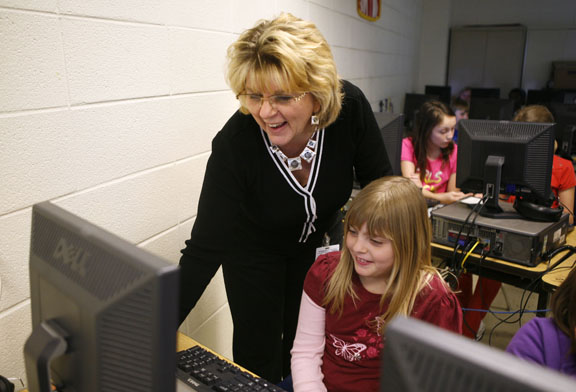
Library media specialist Lorena Webb helps 3rd-grade student Savannah Blanton with her PowerPoint about the Liberty Bell at Waco Elementary School (Madison County). The students were learning how to use PowerPoint by creating a presentation about a national monument. Photo by Amy Wallot, April 2011
By Matthew Tungate
matthew.tungate@education.ky.gov
Go to dinner with Charlene McGee, and you may see her 4-year-old grandson use her husband’s cell phone to watch a movie and use her phone to play a game at the same time.
“That is what these kids are growing up doing,” said McGee, district technology coordinator and chief information officer for Madison County school district. “We put them in the cradle with a digital music box. They learn to punch whatever number to hear whatever song by the time they’re 6 months old.”
Yet when students get to school, they are told to “power down and sit and be quiet.”
Not in Madison County. Students in schools across the district can use their own Internet-enabled devices to log on to the district’s guest wireless network – a plan that had some adults concerned, McGee said.
“The kids are getting there anyway. They have smartphones,” McGee said. “The kids were texting with their phones in their pockets. It is the world in which the students are growing up.”
“Should we care that they’re on Facebook at lunch if they’ve brought their iPads from home? Why are we trying to stop them? We need to embrace it.”
It is that kind of progressive attitude toward technology that has twice landed Madison County in the Top 10 for districts its size in the country for using technology.
In October, Madison County was named a top 10 U.S. school district in digital technology for the second year in a row. The seventh annual Digital School Districts Survey by the National School Boards Association (NSBA) and e.Republic’s Center for Digital Education recognizes exemplary school boards and districts’ use of technology to govern the district; communicate with students, parents and the community; and to improve district operations.
“With rising expectations and shrinking resources, these districts have utilized technology to effectively serve their students, educators and community members,” NSBA Executive Director Anne Bryant said. “School boards across the country should look to these districts for ideas about using technology to make their work as a board more transparent and their district operations more efficient.”
Survey a way to gauge priorities
McGee, who has been with the school district for 21 years and in her present job for four years, said the Digital School Districts Survey is a learning opportunity to see if Madison County is heading in the same direction as national experts think school districts should be going.
“That means Madison County has the national pulse on where school districts need to be moving to get students prepared for this digital age that we are living in,” she said. “I just think it’s a great way to know if we’re really doing what we should be doing to prepare students for what ‘grade 13’ will be.”
The survey asks 26 questions ranging from topics such as a district’s online presence and whether school board and district officials can be reached electronically to student and teacher training on technology. The district has an opportunity to give a narrative and provide evidence to back up its answers.
McGee said the survey, which took about three hours to complete, wants districts to prove they are striving to advance the use of technology for students, staff, board members and parents.
McGee expects the district to fare even better in the 2011 survey. Madison County Superintendent Tommy Floyd has started a Twitter account and a Facebook page; school board members have Madison County school district e-mail accounts; and the district’s One Call system that notifies parents of important messages now goes immediately on the district’s webpage and runs on a county public television station.
“There is so much that we are doing, I look for us to be in the top five next year,” she said.
Technology ubiquitous for teachers, students
Besides its high marks for communication, Madison County has excelled in putting technology in the hands of teachers and students, McGee said.
All Madison County classrooms are equipped with interactive classrooms, which include at least a projector, interactive school pad for teacher and student interaction, document cameras, and student response systems, which allow the teachers to get immediate feedback from students.
Lorena Webb, a library media specialist at Waco Elementary with 17 years of experience, said she uses the interactive pad, document camera, student response system; software programs such as Movie Maker and PowerPoint; the Kentucky Virtual Library (KYVL); and an online cataloging system (Destiny).
“I believe using these technologies brings teaching and learning to the 21st century,” she said. “It allows me to provide students with the resources to research and present information, and allows them to go beyond the use of pencil and paper.”
Webb starts teaching basic PowerPoint to 1st graders and builds on that each year. Her intermediate level students are creating movies about the regions of Kentucky.
“They have been very excited about their projects from research to the actual creation of their movie,” she said. “They always want to go beyond what I have asked them to do and want to include other media in their presentations.
“I don’t think I would have that type of eagerness if we just were creating a written report.”
Lisa Caudill, a 32-year teaching veteran who teaches Read180 to 9th and 10th graders at Madison Southern High School, has her students use Movie Maker to create book trailers. She also constructs vocabulary games and vocabulary tests on the computer that students use as part of their assessments.
“The students like the vocabulary reviews and tests instead of paper/pencil tests,” Caudill said. “They also love the creative outlet of making the book trailers.”
Those are just some of the many technologies teachers and students use, McGee said. But Madison County would not be as successful if the district and teachers did not work together on professional development, she said.
“The district recognizes that continuous PD is the way to go,” McGee said.
Each Thursday, a technology integration specialist (TIS) helps teachers figure out how to use technology in their lessons, she said.
The district also offers summer professional development, including instruction-based use of technology and skill-based training on how to use different technologies the district offers. Between one-third and one-fourth of all teachers in the district attend that training without getting paid to go, McGee said.
“That speaks volumes to me – their proactive thinking and wanting the technology in their classrooms and in the hands of the students,” she said. “Technology’s not just to be in the hands of the teacher. It’s to be in the hands of the student.”
Webb said she takes advantage of the summer professional development and shares what she learns with colleagues in her building.
“Our district TIS and technology department work diligently to ensure new technologies are presented every year,” she said. “They also provide additional information about technologies that we currently have.”
Caudill said she tries to attend conferences outside the district for ideas of how to use technology, including attending the National Read 180 summer conference the past two years.
“I learned more from that conference than any I have attended in my 32 years of teaching,” she said.
Teachers attend conferences and do research to find out what is available to them, McGee said.
“They should feel challenged to do research for best practice on the use of technology in a K-12 environment and for knowing that this is the world these students are growing up in, to constantly be researching on how they can make their courses, their classes, their content areas more engaging for the students, and I think technology is always going to play a part in that,” she said.
The district even has students helping teachers use technology in their lessons.
McGee said she is especially impressed by one of the superintendent’s initiatives, the Superintendent Teen Task Force. A group of juniors and seniors are taking a traditional “sit-and-get” lesson and showing teachers how it could be more engaging with interactive technology.
Why is technology important?
“My belief is ‘Instruction drives technology,’ not that technology should drive instruction,” McGee said.
The district has multiple technology committees that review different technologies, but they all have one goal in mind, McGee said.
“Everything is research-based – How is it going to improve instruction for the students?” she said.
The technology itself is part of the learning process, McGee said, “to help our students become more marketable in a global economy and be competitive walking out of Madison County schools into a college environment, into a workplace, whatever is the next step in a student’s future – are we preparing them for that path?”
“I don’t have the answers,” she said. “No one person has every answer, but we are all on this pathway of digital technology and mobile devices.”
Webb and Caudill both said that Madison County teachers understand the district’s vision.
“Technology is continuously changing the job market,” Webb said. “We must provide our students with the skills to meet the changes, or we are failing them as teachers and leaders.”
MORE INFO …
Charlene McGee, charlene.mcgee@madison.kyschools.us, (859) 625-6010, ext. 6654








Leave A Comment